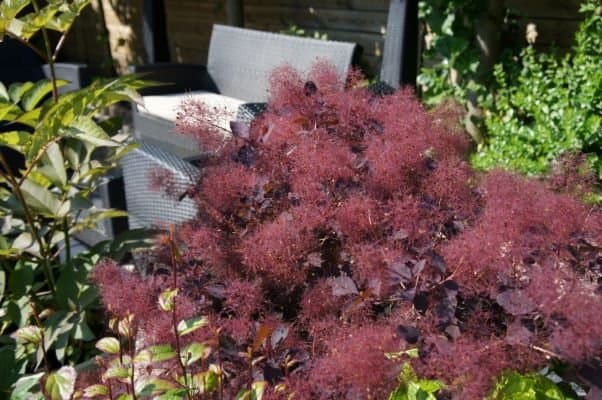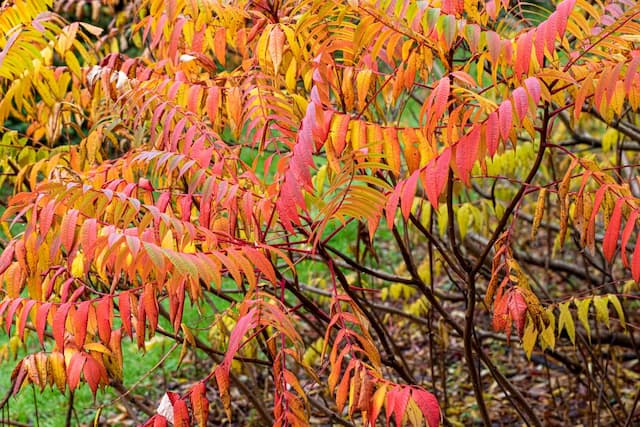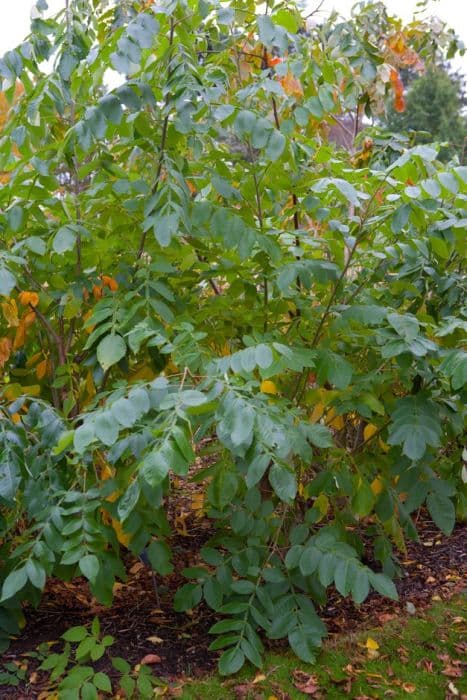Smoke bush Cotinus 'Grace'

ABOUT
Cotinus 'Grace', commonly known as the Smoke Bush or Smoke Tree, is a striking ornamental plant noted for its vibrant foliage and ethereal flower clusters that resemble puffs of smoke. The Smoke Bush showcases leaves that emerge in spring with a rich purplish-red hue and as the seasons change, the leaves can transform, adopting a striking combination of reds, oranges, and yellows before they fall. This deciduous shrub or small tree truly stands out in the landscape. The most distinctive feature of the Smoke Bush is its cloud-like puffs of feathery flowers, which appear in the summer. These smoky plumes are actually composed of a myriad of tiny flowers, giving the plant a soft, misty appearance from a distance. The captivating flowers can vary in color, typically ranging from a pinkish-purple to a light, smoky gray. Smoke Bush also offers a strong structure with multiple stems branching out from its base, forming a rounded and bushy appearance. This branching habit gives the plant a full, robust look, with the foliage adding to its dense appearance. The combination of its unique flowering clusters and its colorful leaves that change throughout the seasons provides year-round interest, making the Smoke Bush a desirable choice for gardeners and landscape designers seeking a plant with both visual appeal and a transformative nature.
About this plant
 Names
NamesFamily
Anacardiaceae.
Synonyms
Grace Smokebush, Grace Smoke Tree, Velvet Cloak.
Common names
Cotinus 'Grace'
 Toxicity
ToxicityTo humans
The Smoke Tree, which is the common name for Cotinus 'Grace', is not known to be toxic to humans. There are no well-documented cases or significant reports of poisoning or toxicity in humans from ingesting or coming into contact with parts of the Smoke Tree. However, as with any plant material, individual allergies or sensitivities can exist, and it is generally advisable to avoid ingesting plants that are not specifically known to be edible.
To pets
The common Smoke Tree, also known as Cotinus 'Grace', does not have a well-documented history of toxicity to pets such as dogs and cats. While there are no significant reports of poisoning from ingestion of this plant by pets, it is still recommended to prevent pets from eating ornamental plants since individual animals might experience adverse reactions or sensitivities that are not widely recognized. If a pet were to ingest Smoke Tree parts, monitoring for any unusual behavior and consulting with a veterinarian if any concerns arise is suggested.
 Characteristics
CharacteristicsLife cycle
Perennials
Foliage type
Deciduous
Color of leaves
Purple
Flower color
Pink
Height
15 feet (4.57 meters)
Spread
15 feet (4.57 meters)
Plant type
Shrub
Hardiness zones
5
Native area
Mediterranean
Benefits
 General Benefits
General Benefits- Attractive Foliage: Cotinus 'Grace', also known as Smoke Bush, displays vibrant foliage in shades of purple, red, and orange, adding striking color to landscapes.
- Seasonal Interest: Throughout the seasons, Smoke Bush offers ornamental value with its spring flowers, summer and fall foliage, and winter structure.
- Drought Tolerance: Once established, Smoke Bush is quite drought-tolerant, making it suitable for xeriscaping or dry garden areas.
- Low Maintenance: Smoke Bush requires minimal care, making it a good choice for gardeners seeking plants that do not need a lot of attention.
- Pest Resistance: This plant is generally resistant to pests, reducing the need for chemical treatments.
- Adaptable: Smoke Bush is adaptable to a range of soil types, as long as the soil is well-drained.
- Privacy Screen: When planted in groups, Smoke Bush can serve as an effective privacy screen or windbreak due to its dense foliage.
- Wildlife Attraction: The flowers of Smoke Bush attract pollinators such as bees, contributing to the ecological health of the garden.
 Medical Properties
Medical PropertiesThis plant is not used for medical purposes.
 Air-purifying Qualities
Air-purifying QualitiesThis plant is not specifically known for air purifying qualities.
 Other Uses
Other Uses- Cotinus 'Grace', commonly known as Smoke Bush, can be used as a natural dye. The leaves and flowers can produce dyes of various colors for fabrics and crafts.
- The dense foliage of Smoke Bush can provide privacy screening in gardens or along property boundaries.
- Smoke Bush branches can be used in floral arrangements for their unique, smoke-like flower clusters and striking autumn leaves.
- When pruned into a standard tree form, Smoke Bush can serve as an attractive focal point in landscape design.
- Its wood can be utilized for making small carvings or woodworking projects, offering a unique color and grain pattern.
- Smoke Bush can be planted on slopes or banks for erosion control due to its extensive root system.
- During the fall, the vivid foliage of Smoke Bush can be used to create natural, decorative wreaths or other autumnal decorations.
- Dried foliage and seed pods from Smoke Bush can be incorporated into potpourri mixes for a natural touch in home decor.
- The plant's resistance to deer browsing can make it a valuable addition to gardens in areas with high deer populations.
- Smoke Bush's ability to thrive in urban environments makes it suitable for use in city landscaping projects to add greenery and enhance aesthetic appeal.
Interesting Facts
 Feng Shui
Feng ShuiThe Smoke tree is not used in Feng Shui practice.
 Zodiac Sign Compitability
Zodiac Sign CompitabilityThe Smoke tree is not used in astrology practice.
 Plant Symbolism
Plant Symbolism- Beauty and Grace: The plant's common name 'Grace' implies an elegant beauty, which can be symbolic of inner beauty and a graceful presence in one's life.
- Smoke and Illusion: Cotinus is commonly known as the Smoke Tree due to its smoky-hued blooms. This can symbolize mystery, the ephemeral nature of life, or the idea of creating illusions or diffuse barriers.
- Transformation and Change: The Smoke Tree's ability to change color through seasons symbolizes transformation and adaptability across various circumstances in life.
- Protection and Safety: In some cultures, tree symbolism often includes protection and safety, which might also extend to the Smoke Tree due to its robust nature.
 Water
WaterThe Smoke Tree, also known as Cotinus 'Grace', prefers deep waterings to encourage an extensive root system but does not like to be overwatered. It requires thorough watering once a week during the growing season, with adjustments made for rainfall. The amount of water should be equivalent to about 1 to 1.5 gallons, depending on the size of the plant and the soil moisture levels. During the winter, when the plant is dormant, reduce watering frequency. In hotter climates or during periods of drought, additional water may be needed. Make sure the water penetrates deeply into the soil rather than just wetting the surface.
 Light
LightSmoke Tree thrives best in full sun exposure, receiving at least 6 hours of direct sunlight daily. The ideal location is where the plant can bask in unfiltered light throughout the day. Partial shade is acceptable but may reduce the vibrancy of the foliage color.
 Temperature
TemperatureThe Smoke Tree performs well in a wide range of temperatures, withstanding winter lows down to around 0°F and tolerating summer highs above 100°F. The ideal temperature range for optimal growth is between 60°F and 75°F. Avoid exposure to extreme cold below 0°F which can cause damage to the plant.
 Pruning
PruningPruning the Smoke Tree is important to maintain its shape and encourage bushier growth. Light pruning can be done at any time to remove diseased or damaged wood. For more extensive shaping or to control size, prune in late winter or early spring before new growth starts. Prune up to one-third of the older stems to ground level to rejuvenate the plant every few years.
 Cleaning
CleaningAs needed
 Soil
SoilSmoke tree 'Grace' thrives in well-draining soil, with a mix of two parts loam, one part peat or compost, and one part sand or perlite being ideal. The soil pH should be slightly acidic to neutral, around 5.5 to 7.0, to promote healthy growth.
 Repotting
RepottingSmoke tree 'Grace' doesn't require frequent repotting as it's a large shrub; it's typically repotted or planted in the ground every few years. Young plants should be repotted once they outgrow their pots, which could be every 2-3 years.
 Humidity & Misting
Humidity & MistingSmoke tree 'Grace' is adaptable and does not require high humidity levels; it will do well in average outdoor humidity conditions. The plant is quite tolerant of dry air and does not have specific humidity needs.
 Suitable locations
Suitable locationsIndoor
Provide bright light, prune for shape.
Outdoor
Full sun, well-drained soil, minimal care.
Hardiness zone
5-9 USDA
 Life cycle
Life cycleSmokebush 'Grace', also known as Cotinus 'Grace', begins its life as a seed that germinates when conditions of light, temperature, and moisture are favorable, usually in the spring. The germinated seed develops into a seedling, which then grows into a young plant with a developing root system and foliage. As it matures, the smokebush 'Grace' enters a vegetative stage where it invests energy into expanding its canopy and root system. During spring to early summer, the plant produces feathery inflorescences that give it a smoky appearance and for which it gets its common name. After the flowering period, the plant may produce seeds which can be dispersed by wind or wildlife to begin a new generation. Over time, with the right conditions and care, smokebush 'Grace' may reach its full mature size, which includes a substantial height and spread, and go through these cycles yearly, experiencing periods of dormancy in winter.
 Propogation
PropogationPropogation time
Early spring
The most popular method of propagation for Cotinus 'Grace', commonly known as Smoke Bush, is through softwood cuttings. This is typically done in the late spring or early summer when new growth is still flexible. Cut a 4-6 inch (10-15 cm) length of stem from the current year’s growth, ensuring that there are at least two sets of leaves present. Remove the leaves from the lower half of the cutting to expose the nodes where roots will develop. Dip the cut end into a rooting hormone to encourage root growth, and then place the cutting into a well-draining potting mix. Keep the cutting moist and covered with a plastic bag or in a propagator to maintain humidity until roots have established, which usually takes several weeks. After rooting, the new Smoke Bush plant can be gradually acclimated to outdoor conditions before planting in its permanent location.




